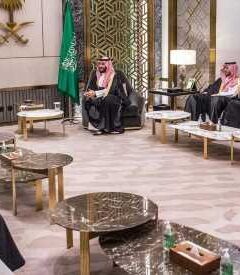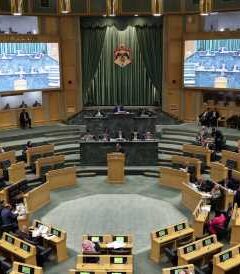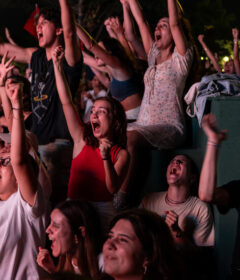Home » Middle East »
Deadly stampede at Israeli religious festival followed years of warnings
MOUNT MERON, ISRAEL (NYTIMES) – The man underneath Mr Avraham Nivin was already limp and lifeless. The men above him were thrashing and flailing. The men to his sides were screaming for help and struggling to breathe.
And crushed in the middle of these limbs and torsos – his legs trapped, his shoes and glasses lost in the melee, his body perpendicular to the floor – was Mr Nivin himself.
“It was an indescribable disaster,” Mr Nivin, a 21-year-old electronics salesman, said Friday evening (April 30). “I thought I was looking death in the face.”
He survived, but 45 others did not – turning a night that began as a pilgrimage for tens of thousands of ultra-Orthodox Jews, and a joyous return to something approaching post-pandemic normality, into one of the deadliest peacetime tragedies in Israeli history.
At least four of the dead were Americans, Israel’s Foreign Ministry said, and two were Canadian, according to Canada’s Foreign Ministry.
By Friday night, the stampede had prompted a surge of soul-searching about religious-secular tensions, the resistance to state authority displayed by some ultra-Orthodox Israelis and, above all, questions of blame, responsibility and negligence.
For more than a decade, there have been concerns and warnings that the religious site on Mount Meron in northern Israel was not equipped to handle the number of pilgrims who flock there each year to commemorate the death of a revered second-century rabbi.
In 2008 and 2011, reports by the state comptroller, a government watchdog, warned of the potential for calamity there.
The leader of the regional government said he tried to close it at least three times. In 2013, the regional police chief warned in an official investigation of the possibility of a lethal stampede. And in 2018, a prominent ultra-Orthodox journalist called it a death trap.
And yet the government authorised this year’s event, raising questions about its culpability and whether its reliance on ultra-Orthodox political parties had trumped concerns for public safety.
On Friday, Prime Minister Benjamin Netanyahu pledged to conduct “a thorough, serious and deep investigation to ensure such a disaster does not happen again.” On a visit to the site, he called for a national day of mourning on Sunday.
“This is an enormous thing that will be remembered for many years to come,” said Mr Gedalia Guttentag, an editor at Mishpacha, a leading Haredi magazine. “We are just seeing the beginning of what it means.”
Israel has been racked by tensions between the secular mainstream and ultra-Orthodox Israelis, also known as Haredim, particularly during the pandemic. Among secular Jews, there was widespread anger about a disregard for coronavirus regulations within parts of the ultra-Orthodox community.
The disaster early Friday largely united the country in shock and grief, but it also underlined some of the divisions in society.
It occurred as up to 100,000 people filled the slopes of Mount Meron late Thursday, in the largest public gathering since the start of the pandemic. Most arrived by buses, but some camped in tents on the mountainside.
It was the night of Lag b’Omer, a holiday that marks the death of a second-century sage and icon of Jewish mysticism, Rabbi Shimon Bar Yochai, who is believed to have been buried on the mountain.
The night reached its crescendo shortly after midnight, as packed crowds gathered in a cramped open-air arena beside the tomb to sing, dance and watch the lighting of ceremonial bonfires.
The festivities turned to horror afterward as celebrants attempted to leave via a steep, narrow gangway that descends down a short set of steps to a narrow, covered passageway.
When they neared the steps to the passageway, some of those at the front tripped and slipped on the metal floor of the gangway, jostled by the weight of the crowds behind them, witnesses said. One witness said the passageway was slippery from spilled water and grape juice.
That created a sudden bottleneck, trapping hundreds of worshippers at the bottom of the gangway. Soon bodies were piled on top of one another, as more and more people left the arena above, trampling the people beneath them.
Israeli authorities had placed no restrictions on the number of attendees, despite warnings by some health officials about the risk of Covid-19 transmission.
Although the sight of so many people gathered together and unmasked may be jarring to much of the world, life in Israel has returned almost to normal in recent weeks after a successful national vaccination drive.
Most of the adult population is fully vaccinated. But many in the crowds were under 16 and not yet eligible for vaccination.
By Friday afternoon, families were rushing to bury their dead before the start of the Sabbath at sundown. The victims included two pairs of brothers, the youngest of whom was 9. Thirteen bodies remained unidentified when the process was halted for the start of the Sabbath.
Condolences poured in from leaders around the world, including from US President Joe Biden, President Vladimir Putin of Russia, King Abdullah II of Jordan and President Mahmoud Abbas of the Palestinian Authority.
For the Haredi community – which was disproportionately hurt by the coronavirus crisis, both by the disease and by the stinging rebukes of secular society – it felt like a particularly cruel turn of events.
“It’s been one blow after another,” Mr Nivin said from his hospital bed in Safed. “It’s something we don’t know how to pick ourselves up from.”
The compound on Mount Meron includes several large gathering grounds with bleachers and stages, connected by a series of alleyways and paths.
The 2008 comptroller report said that various additions and changes to the site had been made without the approval of the local and district planning and building committees.
The report said the access roads and paths posed a special danger, as they were “narrow and not appropriate to accommodate the hundreds of thousands of people who visit the site.” It was along one of those paths where witnesses said the crush of people began.
In 2013, the regional police commander at the time, Mr Roni Atia, concluded in an official report that the site could safely hold only 10,000 pilgrims, and warned that the compound where Friday’s stampede occurred was “one of the most dangerous spots in the site.” The celebrations were strictly curtailed last year because of the pandemic, with few people allowed to attend.
Even as they began to sort out the causes of the tragedy, Israelis united in their grief. Across the nation, they lined up to donate blood for the injured. They cancelled parties and cultural events out of respect. Arab residents of the Galilee came to aid the survivors.
But many of those touched by the disaster come from the most insular, extreme sects of ultra-Orthodoxy that eschew cooperation with the state. And many secular Israelis viewed the rabbis’ intransigence over administration of the pilgrimage site as evidence of an abiding rebellion.
“I don’t see a healing process here,” said Mr Yedidia Stern, president of the Jewish People Policy Institute in Jerusalem. “I’m afraid neither side will take advantage of this event to draw closer to the other.”
Join ST’s Telegram channel here and get the latest breaking news delivered to you.
Source: Read Full Article




